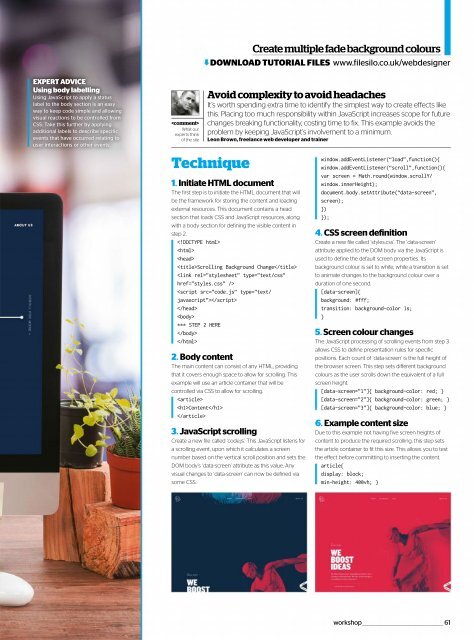Web_Designer_UK__May_2018
Create successful ePaper yourself
Turn your PDF publications into a flip-book with our unique Google optimized e-Paper software.
EXPERT ADVICE<br />
Using body labelling<br />
Using JavaScript to apply a status<br />
label to the body section is an easy<br />
way to keep code simple and allowing<br />
visual reactions to be controlled from<br />
CSS. Take this further by applying<br />
additional labels to describe specific<br />
events that have occurred relating to<br />
user interactions or other events.<br />
<br />
What our<br />
experts think<br />
of the site<br />
Create multiple fade background colours<br />
DOWNLOAD TUTORIAL FILES www.filesilo.co.uk/webdesigner<br />
Avoid complexity to avoid headaches<br />
It’s worth spending extra time to identify the simplest way to create effects like<br />
this. Placing too much responsibility within JavaScript increases scope for future<br />
changes breaking functionality, costing time to fix. This example avoids the<br />
problem by keeping JavaScript’s involvement to a minimum.<br />
Leon Brown, freelance web developer and trainer<br />
Technique<br />
1. Initiate HTML document<br />
The first step is to initiate the HTML document that will<br />
be the framework for storing the content and loading<br />
external resources. This document contains a head<br />
section that loads CSS and JavaScript resources, along<br />
with a body section for defining the visible content in<br />
step 2.<br />
<br />
<br />
<br />
Scrolling Background Change<br />
<br />
<br />
<br />
<br />
*** STEP 2 HERE<br />
<br />
<br />
2. Body content<br />
The main content can consist of any HTML, providing<br />
that it covers enough space to allow for scrolling. This<br />
example will use an article container that will be<br />
controlled via CSS to allow for scrolling.<br />
<br />
Content<br />
<br />
3. JavaScript scrolling<br />
Create a new file called ‘code.js’. This JavaScript listens for<br />
a scrolling event, upon which it calculates a screen<br />
number based on the vertical scroll position and sets the<br />
DOM body’s ‘data-screen’ attribute as this value. Any<br />
visual changes to ‘data-screen’ can now be defined via<br />
some CSS.<br />
window.addEventListener(“load”,function(){<br />
window.addEventListener(“scroll”,function(){<br />
var screen = Math.round(window.scrollY/<br />
window.innerHeight);<br />
document.body.setAttribute(“data-screen”,<br />
screen);<br />
})<br />
});<br />
4. CSS screen definition<br />
Create a new file called ‘styles.css’. The ‘data-screen’<br />
attribute applied to the DOM body via the JavaScript is<br />
used to define the default screen properties. Its<br />
background colour is set to white, while a transition is set<br />
to animate changes to the background colour over a<br />
duration of one second.<br />
[data-screen]{<br />
background: #fff;<br />
transition: background-color 1s;<br />
}<br />
5. Screen colour changes<br />
The JavaScript processing of scrolling events from step 3<br />
allows CSS to define presentation rules for specific<br />
positions. Each count of ‘data-screen’ is the full height of<br />
the browser screen. This step sets different background<br />
colours as the user scrolls down the equivalent of a full<br />
screen height.<br />
[data-screen=”1”]{ background-color: red; }<br />
[data-screen=”2”]{ background-color: green; }<br />
[data-screen=”3”]{ background-color: blue; }<br />
6. Example content size<br />
Due to this example not having five screen heights of<br />
content to produce the required scrolling, this step sets<br />
the article container to fit this size. This allows you to test<br />
the effect before committing to inserting the content.<br />
article{<br />
display: block;<br />
min-height: 400vh; }<br />
workshop _____________________________________________ 61



